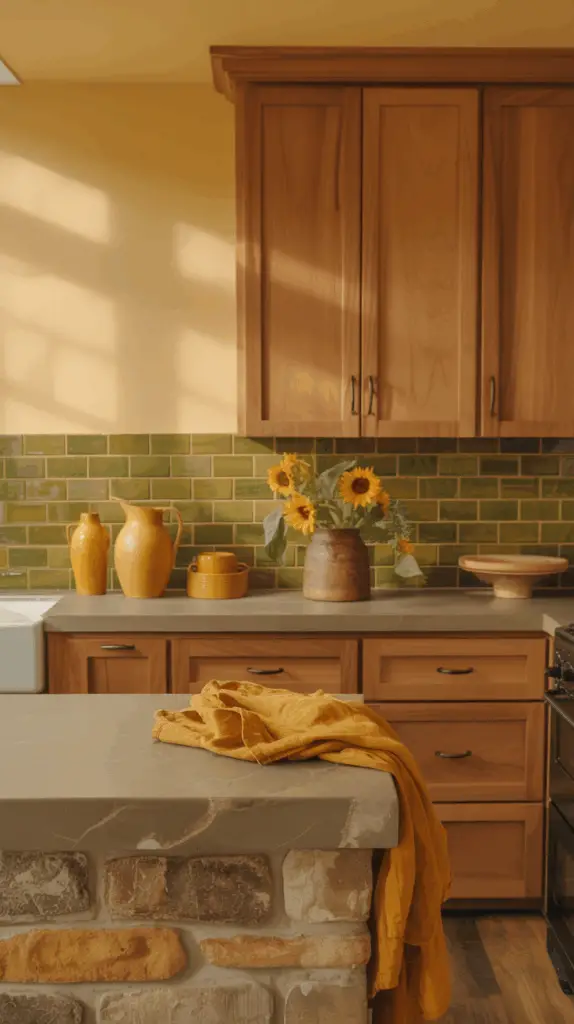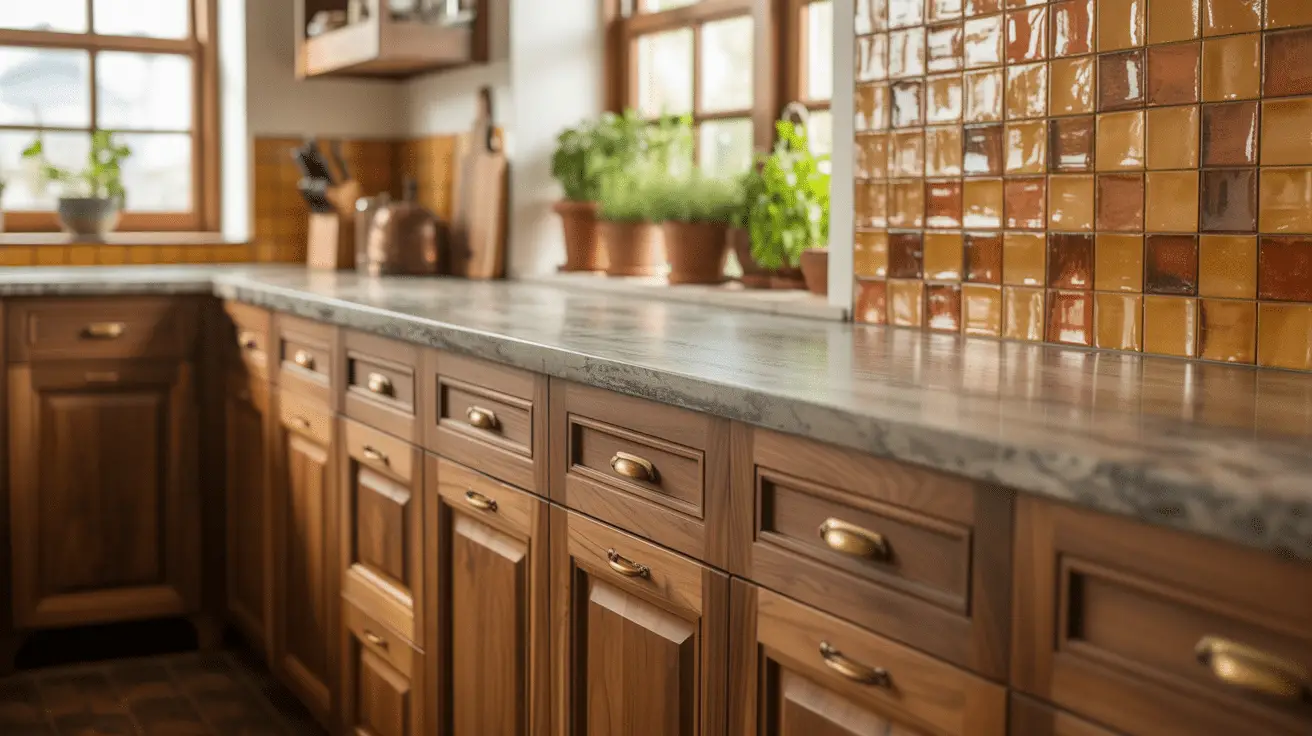Transform Your Home with a Stunning Natural Earthy Kitchen: Design Ideas for a Warm, Inviting Space
Table of Contents
Introduction
The kitchen is often referred to as the heart of the home, and for good reason. It’s where meals are prepared, memories are made, and families gather. But what if your kitchen could feel even more inviting—like a sanctuary where natural elements and earthy tones come together to create an atmosphere of warmth and tranquility? A natural, earthy kitchen can do just that.
As more people look for ways to incorporate sustainable and organic materials into their home decor, the earthy kitchen design trend has been on the rise. Whether you’re renovating your kitchen or starting fresh, the idea of using natural materials, earthy tones, and sustainable design elements can transform the space into one that feels harmonious, calming, and full of life.
In this blog, we’ll explore how you can transform your kitchen with stunning natural earthy designs. From choosing the right materials, such as wood and stone, to incorporating earthy color palettes and unique textures, we’ll guide you through the steps of creating a kitchen that reflects nature’s beauty and brings the outdoors in. Whether you prefer a minimalist style or something more rustic, these design ideas will inspire you to create a space where you can truly feel at home.
1. Choose Natural Materials for a Timeless, Organic Look
The foundation of a natural, earthy kitchen begins with the materials you choose. Opting for organic materials like wood, stone, and clay not only adds beauty but also contributes to an eco-friendly environment. These materials have a timeless appeal, helping to create a space that feels grounded and connected to nature.
Wooden cabinetry, floors, and countertops can bring warmth and texture to the kitchen. Rich, natural wood tones like oak, walnut, or reclaimed wood are excellent choices for creating a rustic or minimalist vibe. For a more modern twist, consider lighter woods like maple or birch to create an airy, bright atmosphere.
Stone countertops made from granite, marble, or quartz can add an earthy touch and bring sophistication to your kitchen. If you’re looking to incorporate a unique element, consider using a raw or honed stone finish, which showcases the material’s natural beauty and imperfections.
Other materials like ceramic tiles, terra cotta, and natural fibers can be used for backsplashes or flooring to complement the wood and stone. Mixing these materials thoughtfully will give your kitchen a layered, organic feel.
2. Earthy Color Palettes to Bring Nature Inside
The color palette you choose is essential for creating a natural, earthy feel in your kitchen. Earthy tones like beige, taupe, olive green, mustard yellow, and warm browns can evoke a sense of calm and connection to the outdoors.
Start with a neutral base for your walls, such as warm whites or soft greys. These colors act as a perfect backdrop for the richer tones found in your materials. For cabinets and furniture, consider deep greens, terracotta, or rust-colored finishes to add dimension and personality to the space.
To complement the natural hues of your materials, incorporate soft greens and browns, which are reminiscent of forest floors, herbs, and foliage. Earth tones also work well with natural textures like stone and wood, enhancing the tactile experience in the space.
For an extra touch of vibrancy, you can incorporate accent colors like mustard yellow, deep red, or earthy orange to bring a pop of color to your kitchen. These colors can be introduced through decor items such as rugs, cushions, or small appliances.

3. Open Shelving for a Rustic, Organic Appeal
Open shelving is a hallmark of natural, earthy kitchen designs. Not only does it make your kitchen feel more open and airy, but it also allows you to showcase the beauty of natural materials. With open shelves, you can display your favorite dishes, cookware, and decorative items, creating a space that feels lived-in and personal.
To maintain the earthy aesthetic, opt for wooden shelves or metal brackets in matte black or brass finishes. Wooden shelves, in particular, bring a rustic charm to your kitchen and complement other natural elements like stone countertops and wooden flooring.
When styling your open shelves, choose organic materials such as ceramic dishes, glass jars, or woven baskets to create visual interest. Incorporating plants, herbs, and flowers can also enhance the natural vibe, bringing a touch of greenery to your kitchen.
While open shelving is a beautiful design element, it’s important to maintain organization to avoid a cluttered look. Use simple, functional containers for dry goods and keep your shelves tidy to ensure your kitchen remains both stylish and practical.
4. Maximize Natural Light for an Airy, Bright Feel
Natural light is one of the most important elements of a natural, earthy kitchen. A well-lit space enhances the beauty of natural materials and creates an inviting atmosphere. Large windows, glass doors, or skylights are great ways to bring abundant natural light into your kitchen, making it feel fresh, airy, and connected to the outdoors.
Consider the placement of your windows or doors to maximize the flow of natural light. If your kitchen doesn’t have large windows, you can still make the most of the light you have by keeping window treatments minimal. Sheer curtains or no curtains at all can allow light to flood into the space, creating a warm, sunlit ambiance.
To complement natural light, use light-colored materials like off-white walls or pale wood flooring to reflect the sunlight and make the room feel even brighter. The combination of light and natural materials will help create a kitchen that feels open, welcoming, and full of life.
5. Integrate Indoor Plants for a Green Touch
No natural, earthy kitchen is complete without a touch of greenery. Indoor plants bring life to your kitchen, enhance the air quality, and add a beautiful natural element to the space. Whether you have a green thumb or not, incorporating plants into your kitchen is a simple way to make it feel more alive and connected to nature.
Consider placing small potted plants on your windowsill, or hanging larger plants from the ceiling to create a lush, vertical garden. Herbs like basil, rosemary, or mint not only look great but can be used for cooking, adding both beauty and function to your kitchen.
For larger spaces, consider incorporating a living wall or a dedicated herb garden to make a bold statement. Plants like ferns, succulents, and snake plants can also thrive in kitchens with good natural light and can be placed in decorative pots to match your earthy aesthetic.
6. Blend Modern and Natural Elements for a Balanced Aesthetic
While natural, earthy kitchens often lean toward rustic or minimalist styles, blending modern design elements with natural materials can create a balanced, timeless aesthetic. Incorporating sleek, modern fixtures like stainless steel appliances, marble countertops, or clean-lined lighting fixtures can add a sophisticated contrast to the organic textures of wood and stone.
The key to balancing modern and natural elements is to keep the design cohesive. For example, pair a sleek marble island with wooden cabinetry or incorporate matte black hardware to complement the natural materials. By mixing and matching these elements thoughtfully, you can create a kitchen that feels both contemporary and earthy.
This fusion of styles allows you to create a space that feels fresh and current while still embracing the timeless beauty of nature. Whether you prefer a slightly industrial feel or a more refined, contemporary look, blending these elements ensures that your kitchen remains functional, beautiful, and enduring.
7. Sustainable Design Choices for a Green Kitchen
As sustainability becomes increasingly important in design, incorporating eco-friendly materials and features into your natural, earthy kitchen is a great way to enhance its environmental impact. From using reclaimed wood for cabinetry to installing energy-efficient appliances, there are numerous ways to make your kitchen both beautiful and green.
Start by choosing materials that are sustainably sourced, such as bamboo flooring, reclaimed wood, or recycled glass countertops. Look for appliances with energy-efficient ratings and consider installing a composting system or water-saving fixtures to minimize your environmental footprint.
If you want to take it further, incorporate eco-friendly paint and finishes, which use fewer chemicals and are less harmful to the environment. By making sustainable design choices, you can create a kitchen that not only looks stunning but also supports a healthier planet.
Conclusion
Transforming your kitchen into a stunning natural earthy retreat is all about creating a space that connects you with nature, promotes relaxation, and fosters a sense of tranquility. By incorporating natural materials, earthy tones, and thoughtful design elements, you can craft a kitchen that feels both luxurious and grounded.
From choosing the right materials and colors to adding indoor plants and maximizing natural light, every detail counts when creating a natural, earthy kitchen. Whether you prefer a rustic, minimalist, or modern aesthetic, these design ideas will help you achieve a balanced, timeless look that enhances both the functionality and beauty of your home.
By incorporating natural elements and sustainable practices, you’ll not only create a beautiful space but also contribute to a healthier, more eco-friendly home. So, take inspiration from nature, and start designing the earthy kitchen of your dreams today.

